The recent influx of refugees and migrants into Europe has resulted in a rising tide of nationalism and a populist backlash throughout the west. Tensions over how citizens of the west view border politics are also visible in the ways in which they project their identities or share their stories on social and digital media.
Several reports have highlighted the increasingly influential role mainstream and social media play in shaping both the perceptions and outcomes of population movements into western democracies. Mainstream media discourses rely on: broad portrayals which stereotype; the use of aggregated statistics, and, often, the de-personalizing of complex issues. This results in overt generalisations, reductionism, a lack of depth, and more recently, a global populist political backlash.
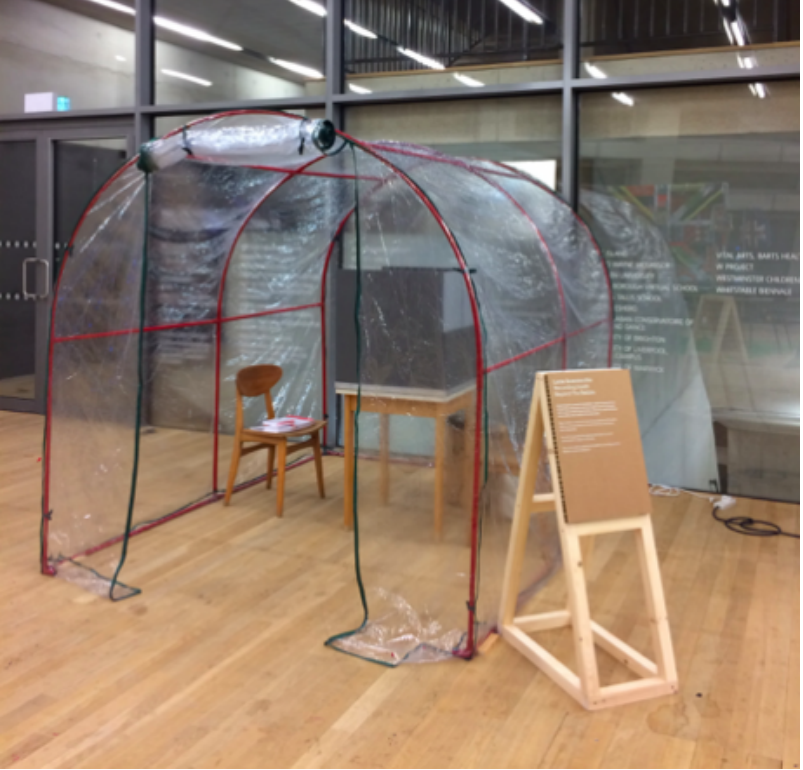 The Audio Booth; Photo Credit: Lucia Scazzocchio. All rights reserved.
The Audio Booth; Photo Credit: Lucia Scazzocchio. All rights reserved.
Following the European Referendum in Britain, for example, the Centre for the Analysis of Social Media at the think tank Demos undertook research on the rise of xenophobia and racism on Twitter. Looking at the ways in which this rise may have been related to campaigning tactics and the referendum result, the study also gives an indication of the ways in which Twitter was used to both report hate speech incidents and to express solidarity with migrants. Expressions and stories of migrant solidarity, primarily through the widespread online campaign of the #1DayWithoutUs activist group, sought to counterbalance xenophobic sentiments, often by offering a multiplicity of migrant voices and experiences in Britain today.
The expression of emotion is key for the spread of moral and political declarations in online social networks.
Looking at this campaign on Twitter, digital culture researcher and author here, Giota Alevizou, together with Photini Vrikki, a digital humanities scholar at Brunel University, used digital methods to investigate different kinds of affective and factual narratives about digital citizenship, identity and contentious spheres of belonging. Insights from this study, like in others, point not only to the role digital and social media may have had in promoting engagement between and among migrants and host communities, but also to the need to examine how the diffusion of emotional or moralised content in social media relates to other modalities that mediate narratives of identity and belonging at a crossroads.
Certainly, the expression of emotion is key for the spread of moral and political declarations in online social networks. But what depth and impact do our projected selves and voices have if they are out of context, trapped in the babble of noise social and mainstream media often create when addressing the politics and realities of migration?
Inspired by this question Giota Alevizou and artist Lucia Scazzocchio worked together to animate the ‘art of listening’. ‘Beyond The Babble’ was an interactive and participatory audio-focused installation, part of the ‘Who Are We?’ Tate Exchange Programme every day from the 14th-19th March. It explored questions of identity, belonging and the more limited impact that more nuanced voices may have. We argue that these voices go beyond the noise of social media, but that they can also be amplified by those same social media.
But what depth do our projected selves and voices have if they are out of context, trapped in the babble of noise?
As a ‘social broadcaster’, Lucia uses digital audio and radio techniques to explore how individual storytelling and voiced ‘declarations’ not only empower the narrator as they are articulated, but can create shared empathy and deeper understanding for the listener when heard in the right context, often providing insight into wider stories and current debates. The installation aimed to stimulate three types of experience designed in three separate formats:
- The first was the ‘audio booth’ inviting participants to self-reflect through the act of conversation.
- The second was an onsite sound installation that would encourage audiences and publics to tune into each narrative through the ‘babble’ of noise coming from the surrounding exhibition space.
- The third format took the audio out of the exhibition space into the public realm through the sending of ‘audio postcards’ (audio tweets).
The art of listening
In discussing the ‘art of listening’ vis-a-vis ‘the art of voicing’ in a previously published dialogue, we thought about how to get participants to reflect more deeply about home, belonging, citizenship and activism. Lucia used a radio interview recording technique to move away from the ‘superfluous ephemerality’ of declarations in spaces such as Twitter. In a sense, it was an opportunity for individuals to express confessional and autobiographical narratives in a different format, without having to worry about the issues of exposure, breaches of privacy and surveillance that have become more prevalent.
In what follows, we discuss what the installation meant for us and for the participants, drawing on some themes and quotes that were common in their stories.
Who are we, then, in terms of understanding our projections, identities, our stories and contributions in a socially mediated world? What is the capacity of sonic art and social broadcasting to animate the politics of identity and belonging as well as debates about digital citizenship?
What is the capacity of sonic art and social broadcasting to animate the politics of identity?
Using a transparent plastic bubblewrap to evoke the physical manifestation of ‘social noise’, Lucia aimed to communicate how we strive to manifest our individuality and be heard whilst at the same time adding to social and media noise from the outside world, the recording booth structure plays with notions of public and private space, self-reflection and self-representation, and the juxtaposition of the desire for exposure vis-a-vis privacy.
The audio recording booth was created as an enclosed, semi/private space, inviting participants to enter it as a safe space. And yet once inside its transparent structure, they were completely visible to passers-by, representing the false sense of security often created by online and social media platforms.
Once inside the structure, each participant was asked to sit on one side of a box divided into two sections, facing a mirror with their reflection. They would be aware of the space around them, but at the same time it would feel like a private, intimate space. They are asked to wear a pair of headphones and speak into a microphone just as like as if they were calling into a mini radio studio where you can’t see the host. The participant is lulled into a private, self-reflective conversation where they can hear their own voice via the headphones and see their reflection in the mirror. This creates an uncomfortable, yet on the whole revelatory, experience for the participant as many enter into a guided stream-of-conscious style monologue, invited also to discover something about themselves as well as reveal their thoughts and opinions.
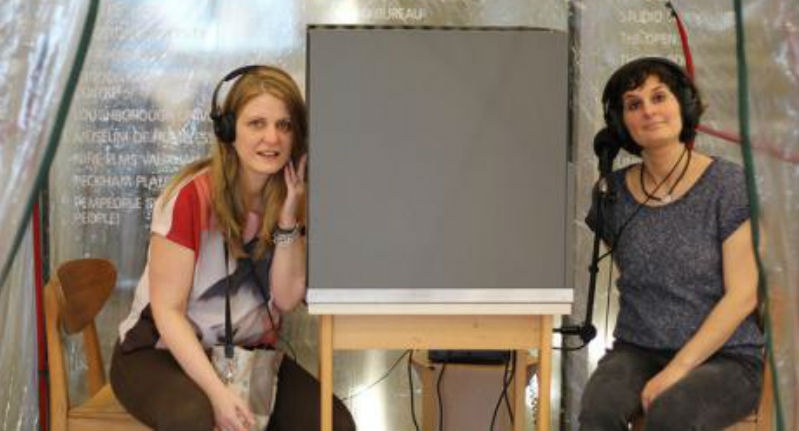 Inside the Beyond the Babble Booth; Photo Credit: Giota Alevizou. All rights reserved.
Inside the Beyond the Babble Booth; Photo Credit: Giota Alevizou. All rights reserved.
As participants were lulled into a private conversation – and what would appear like a private space – passers-by were able to glance at them. Again, although the conversations remained private at the moment of recording, snippets from the product or recording would become available through broadcasting on Twitter – known by the speaker.
Designed to represent a way to hear individual stories through ‘the babble of social noise’, the sound installation located above a selection of window seats around the exhibition space. Through the speakers that listeners could ‘tune in’ to each participants edited self-reflective monologue and therefore tune out of the noise around them. 24-second audio postcards or ‘audio tweets’ edited from the booth conversations were posted throughout the week as a ‘live’ representation and synthesis of the piece.
Radio scholars have argued that as receiving technology, radio has layered the spaces of everyday life and given both voices and listening ears to a range of trans-border communities on both local and global scales. Certainly the audio booth and the sound installation, both in the exhibition space at Tate Modern and on Twitter, used radio aesthetics to help participants formulate or resurrect memories about transnational experiences of identity, belonging and ‘civic-ness’. Through the reposting of selected, short audio declarations on Twitter, we aimed to expose hybrid and subversive notions of being digital citizens: by emphasising the depth and emotionality of ‘critical voices’ while striving to cut through the platform’s ‘datafication’ effect and the impact this may have in promoting a datafied public sphere.
Sonic art and digital citizenship
Can sonic art and social broadcasting help animate ideas about the politics of identity, belonging and (digital) citizenship? As radio scholar Siobhan McHugh argues, the podcasting revolution of recent times has revived interest in the crafted audio storytelling form. Through 'Beyond the babble', we used radio aesthetics to develop and share auditory experiences of home, belonging, collective identities and activism that challenge stereotypes and give depth to aspirations for solidarity and conviviality. There are many aspects to this and elaborating would be beyond the scope of this short paper, yet we can highlight some aspects drawing on 25 of the recorded interviews.
How did the participants reflect upon their own positions within the very immersive politics of identity and digital activism? As they listened to the echo of their voices, mirroring their image, many referred to echo chambers that social media potentially create. Others referred to the expression of moral emotion as key to the spread of both honourable and vitriolic ideas pertaining to the circulation of political, and often activist, ideas in online social networks, a process that some call “moral contagion.” Many participants emphasised that the very same social media platforms that are used to mobilize citizens and celebrated as means for civic emancipation are also platforms for executing control and spreading hate. As such they could easily stifle meaningful political action. Most notably, as two participants voiced, particularly referring to post-referendum online behaviours in the UK:
Hate is a very easy thing to sell and people are always easy to jump on the bandwagon of patriotism... on the other scale, people can become more easily together and more connected and gain a view… In online spaces [you] can gain more knowledge of the world around you or you can look for an echo-chamber or a soundboard where people agree with and you become vindicated in your personal beliefs.
What I find problematic in the nature of social media is that it often lacks context; that’s the challenge in social media to provide context and information for people, so that when they gather together there’s a proper depth about a purpose so that they can act appropriately and effectively… So, I think it’s possible that it needs to be done with depth.
Where’s then the depth and the context on the expressions of lived identities and spheres of belonging? Last year, Theresa May infamously stated that “if you believe you’re a citizen of the world, you’re a citizen of nowhere”, to insist, as Sara de Jong and Alena Pfoser discuss in another contribution to this special feature, on national ties and obligations. Conversely, reflecting on home and belonging most participants stressed a sense of fluidity and cultural syncretism, that is evocative of the much-celebrated, London-based elements of multicultural conviviality. Certainly one would expect it from visitors to an event such as Who Are We? in London’s Tate modern. It evokes to an extent, what Abdelmalek Sayad’s sociology of migration refers to as the ‘double absence’, which is often, we would argue, juxtaposed with an aspiration to voice recognition. As one participant who has been seen as particularly critical of the mixed-transient of May’s statement of fixed ties and obligations, puts it:
What is Home for me? It’s that you are always at home and always homesick.
I belong to multiple nationalities and multiple citizenships and national citizenships and belonging to one doesn’t make it exclusive to the other...
It’s not easy growing up figuring out where you belong; You have to learn the skill to be able to identify how you are going to take the various different bits from your various different cultures and turn them into an identity; but I think recognizing different bits that belong to different influences doesn’t mean you don’t mean you are not a complete person or that you are less of a group that you are another.
Turning to the idea of citizenship, there were two mainly distinctive camps: many participants referred to it in spatial, legal and administrative terms that may create more exclusion and classificatory boundaries. Others referred to it in terms of values (of solidarity and contribution) as well as rights and responsibilities to act, that involves small big battles and small acts of kindness.
Is it a duty or a right? I see a good citizen as being respectful to other people; unfortunately it’s been wrapped up in a piece of paper and erases any humanity from it. We should be bringing the humanity to it… and what politicians and the media have done, during and after the Referendum, is creating a sense of whether you either belong or you don’t. That becomes divisive, and you’ve lost the essence of it.
And, as another participant who’s recently ‘secured’ refugee status and has applied for citizenship after 10 years of living in Britain, states:
We want to focus on ‘humanship’ because citizenship represents too much struggle to get it…
Lucia and Giota discussed the sound installation (of the interviews) with a frame of civic media in mind, mixing the technologies (in this case, digital audio and social media) and practices that can produce and reproduce the sense of our being in the world with others.
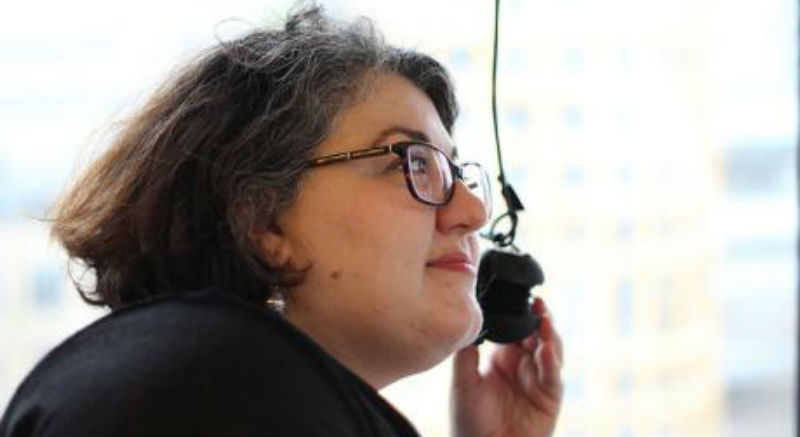 Participants listening to sound installation: Photo Credits: Giota Alevizou. All rights reserved.
Participants listening to sound installation: Photo Credits: Giota Alevizou. All rights reserved.
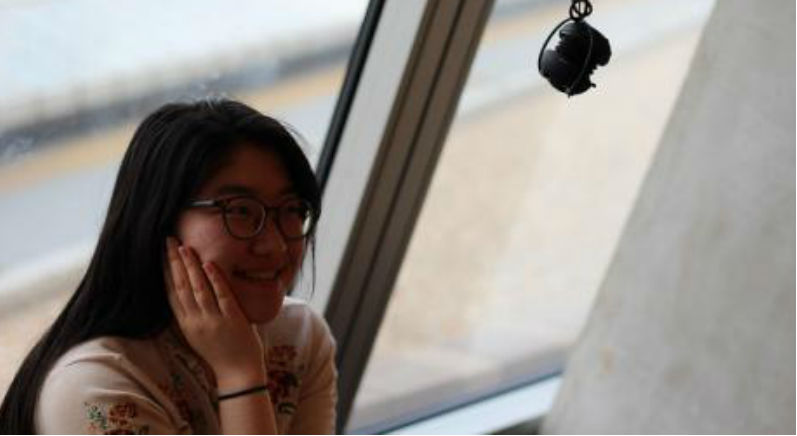 Participants listening to sound installation: Photo Credits: Giota Alevizou. All rights reserved.
Participants listening to sound installation: Photo Credits: Giota Alevizou. All rights reserved.
Audio-scaping also took the form of 24-second audio postcards or ‘audio tweets’ edited from the booth conversations were posted throughout the week as a ‘live’ representation and synthesis of the piece.
The final manifestation of ‘Beyond The Babble’ was the re-creation of the sound installation in digital form, a digital audio-visual archive( see above), emulating the act of being able to tune in and out of the noise and listen to edited version of each participant’s reflections as a synthesis of what had been revealed in the ‘booth’ by each participant reflecting and sounding like who we are.
This article is published as part of an editorial partnership between openDemocracy, The Open University and Counterpoints Arts to reanimate the Tate Exchange project in which academics and artists together ask who – during a time when the lines marking out citizens, borders and nations are being redrawn, or drawn more starkly – 'we' are, and who gets to decide.
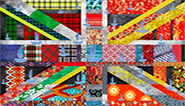
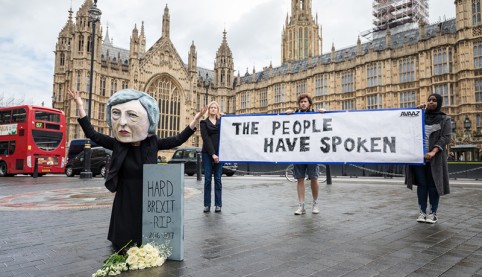
Rate and Review
Rate this article
Review this article
Log into OpenLearn to leave reviews and join in the conversation.
Article reviews